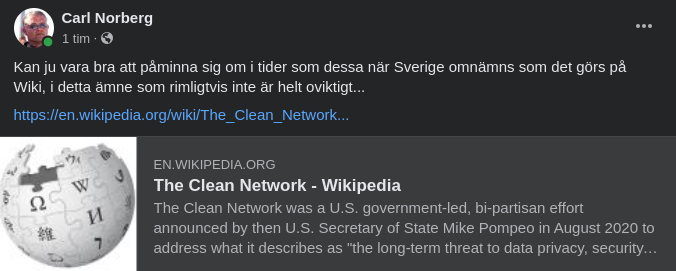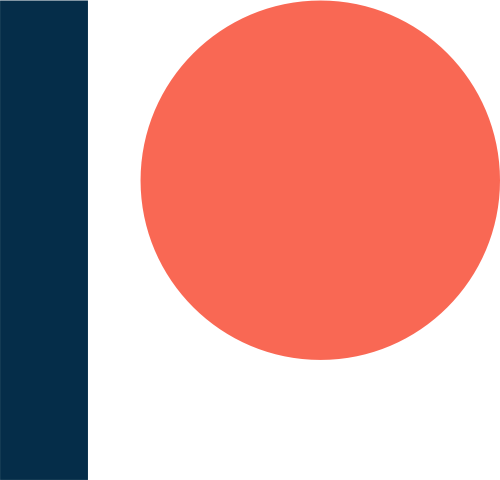Det Rena Nätverket

https://en.wikipedia.org/wiki/The_Clean_Network
The Clean Network was a U.S. government-led, bi-partisan effort announced by then U.S. Secretary of State Mike Pompeo in August 2020 to address what it describes as "the long-term threat to data privacy, security, human rights and principled collaboration posed to the free world from authoritarian malign actors." Its promoters state that it has resulted in an "alliance of democracies and companies," "based on democratic values."[1] According to the Trump administration, the Clean Network is intended to implement internationally accepted digital trust standards across a coalition of trusted partners.[2][3][4][5]
In December 2020, the United States announced that more than 60 nations, representing more than two thirds of the world's gross domestic product, and 200 telecom companies, have publicly committed to the principles of The Clean Network.[6][7][8] This alliance of democracies includes 27 of the 30 NATO members; 26 of the 27 EU members, 31 of the 37 OECD nations, 11 of the 12 Three Seas nations as well as Japan, Israel, Australia, South Korea, Singapore, Taiwan, Canada, New Zealand, Vietnam and India.[9]
The term "Clean Network" was coined by U.S. Undersecretary of State Keith Krach, who initially led the initiative, which includes officials in the Treasury Department, the Office of the U.S. Trade Representative, the National Security Council, and the Commerce Department. According to Bloomberg, Krach is credited with coordinating a variety of national and regional approaches to shape a more unified international project, relying on trust more than compulsion—a notable change in tone after years in which the Trump administration pursued a go-it-alone, "America First" strategy.[8] On April 22, 2021, David Ignatius of the Washington Post stated that Krach's Clean Network provides continuity with the Biden administration's desire to get democracies together on the same playing field on technology.[10]
Krach described the Huawei effort as a “beachhead” in a wider battle to unite against Chinese economic pressure in everything from investment to strategic materials that bears the hallmarks of 'good old fashioned' diplomacy, in contrast to a somewhat more confrontational style at the beginning of the administration.[8] The Wall Street Journal wrote that the Clean Network will be perhaps the "most enduring foreign-policy legacy" of the last four years.[11] Chinese foreign ministry spokesman Zhao Lijian referred to the Clean Network as a "US surveillance network" and "consolidation of US digital hegemony".[12]
Researchers have noted that the announcement of the Clean Network was met with indifference in many major European countries, among concerns that the initiative would fragment the internet, with many also skeptical of US claims that Huawei poses an uncontrollable security threat. Several European countries in the Clean Network have since allowed Huawei to build their non-core 5G networks.[13][14] A December 2021 op-ed by historian Arthur L. Herman and former U.S. national security advisor Robert C. O'Brien noted that only eight countries joined the US-led ban on Huawei's 5G equipment, compared to the more than 90 countries that signed up with Huawei, including several NATO members and regional allies.[15] Herman and O'Brien argued that the US have not offered a viable alternative to Huawei's network, and failed to utilize wide spectrum options.
Overview[edit]
On August 5, 2020, U.S. Secretary of State Mike Pompeo launched the Clean Network, which is the State Department’s comprehensive approach to address what it sees as the long-term threats to data privacy, security, and trusted collaboration posed by malign state actors. It is rooted in internationally accepted "Digital Trust Standards" and represents the execution of a multi-year, enduring strategy built on a coalition of trusted partners. According to Pompeo, the Clean Network emphasizes the importance of securing the entire 5G information technology ecosystem, including all extensions and accessories. The United States government sees these efforts as part of its commitment to an open, interoperable, reliable, and secure global Internet based on shared democratic values and respect for human rights.[16][17]
The State Department looked for a range of commitments from countries and foreign telecom providers to build their 5G networks without Hauwei or ZTE equipment, and offered financing from the Exim Bank or USAID for Ericsson and Nokia equipment.[18][19] The State Department pressed countries and firms to sign MoUs and make official statements supporting the initiative.[16] The EU formed a task force on 5G network security in March 2019, which released standards in January 2020, known as the EU Toolbox on 5G Cybersecurity,[20] that did not explicitly ban Hauwei equipment, but instead suggested each country should evaluate high-risk suppliers. Countries that have committed to build networks implementing the EU Toolbox standards are counted at counties participating in the Clean Network.[21]
United States Under Secretary of State for Economic Growth, Energy, and the Environment Keith Krach was the initial lead advocate of the U.S. government's push to prevent the use of potentially high-risk Chinese technology in sensitive systems around the world.[8]

According to Bloomberg, the Clean Network effort to create a united economic front has similarities with George Kennan's “long telegram” of 1946 to the Soviet Union. David Fidler, adjunct senior fellow for cybersecurity and global health at the Council on Foreign Relations, made this claim in a blog post in 2020. Kennan formulated the Cold War strategy of containment, which the Chinese claim is now being used against them.[8]
Under Secretary Krach traveled to Asia, Europe, South America, and the Middle East to secure commitments from more governments to join the U.S. effort. "The success of the Clean Network has taken all the momentum away from Huawei," Krach said. "When we looked at this six months ago it looked like Huawei was unstoppable."[4][22]
The Clean Network and the EU 5G Clean Toolbox, the U.S. government claims, have paved the way toward protecting citizens’ privacy, companies’ intellectual property, and countries’ national security from "aggressive intrusions" by malign actors, such as the Chinese Communist Party and its surveillance and data collection tools, such as Huawei. "Countries and companies are more and more asking the question, 'Who do we trust?'" Krach said. "The answer’s coming back, it’s certainly not Huawei because they’re the backbone of the Chinese Communist Party’s surveillance state."[4]
The "Clean Network" brand replaced the original name of "Economic Prosperity Network" in which trusted democracies and the private sector form an economic alliance. It was conceived to have three components from initiatives that were already underway: a Clean Network for communications that is free from untrusted vendors; a Blue Dot Network for global infrastructure investment to counter China's "Belt and Road" initiative; and an Energy Resource Governance Initiative to secure supplies of rare earth metals and other strategic minerals.[8]
Visa ditt stöd till det informationsarbete Carl genomför
Patreon
Swish

